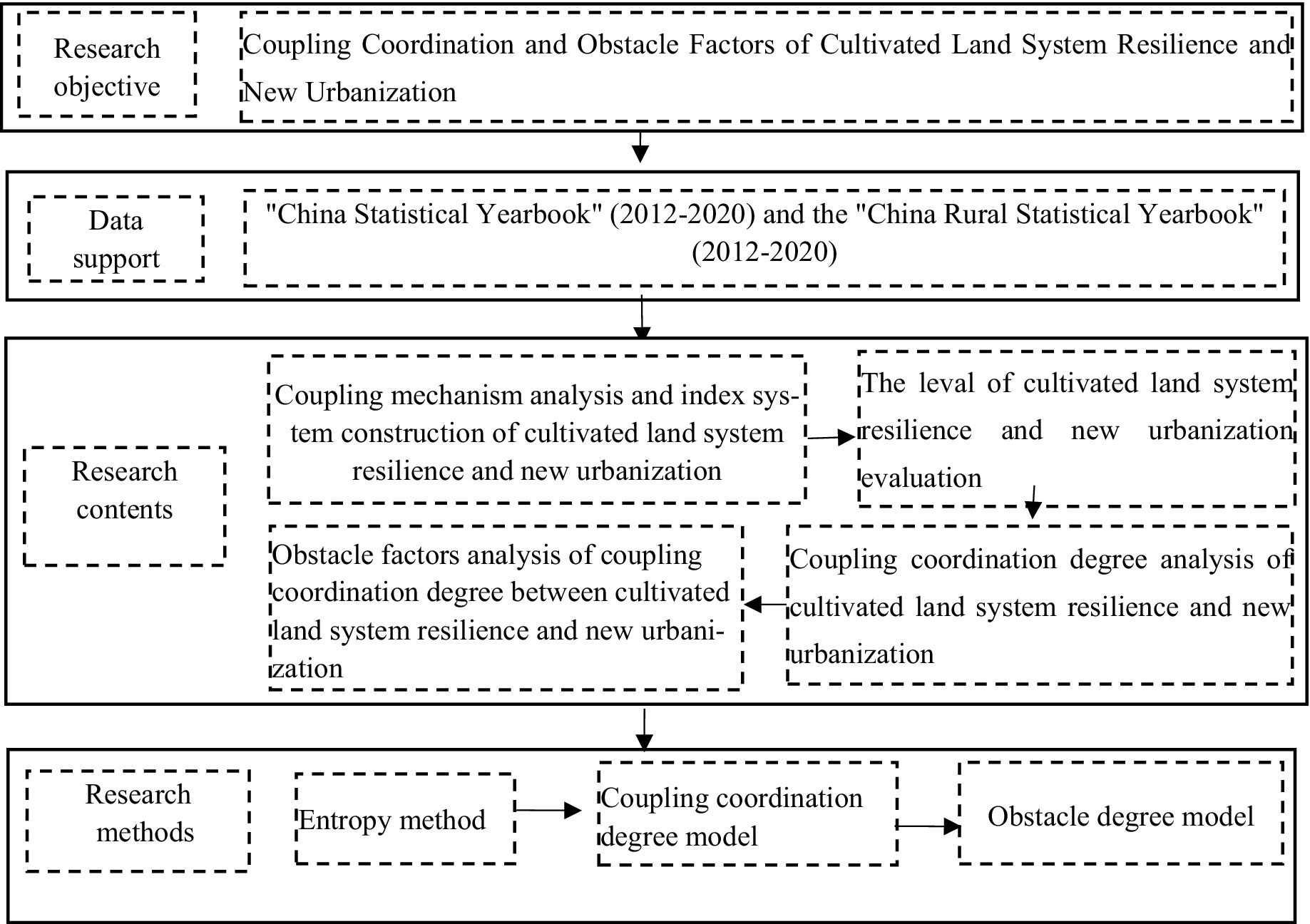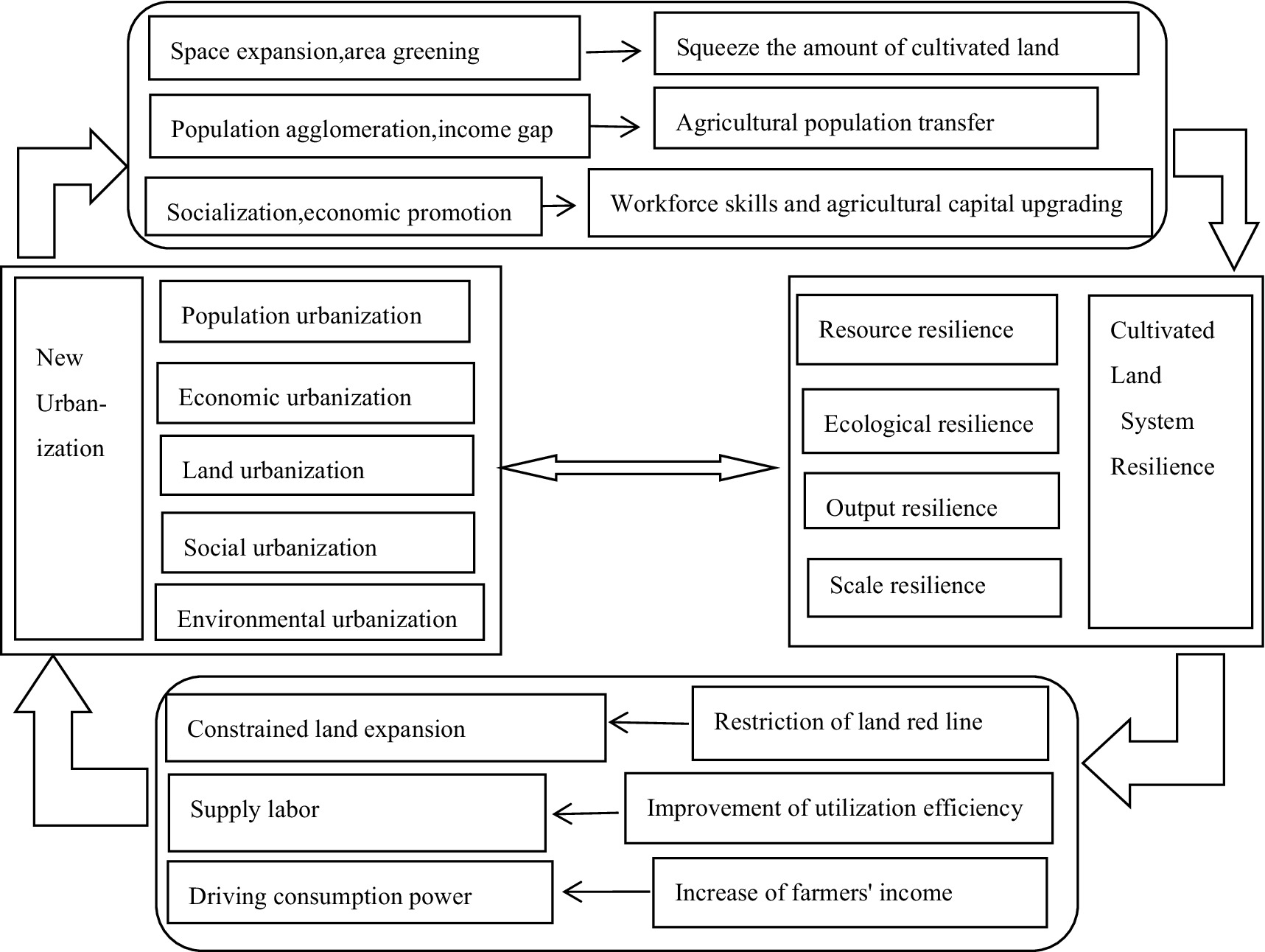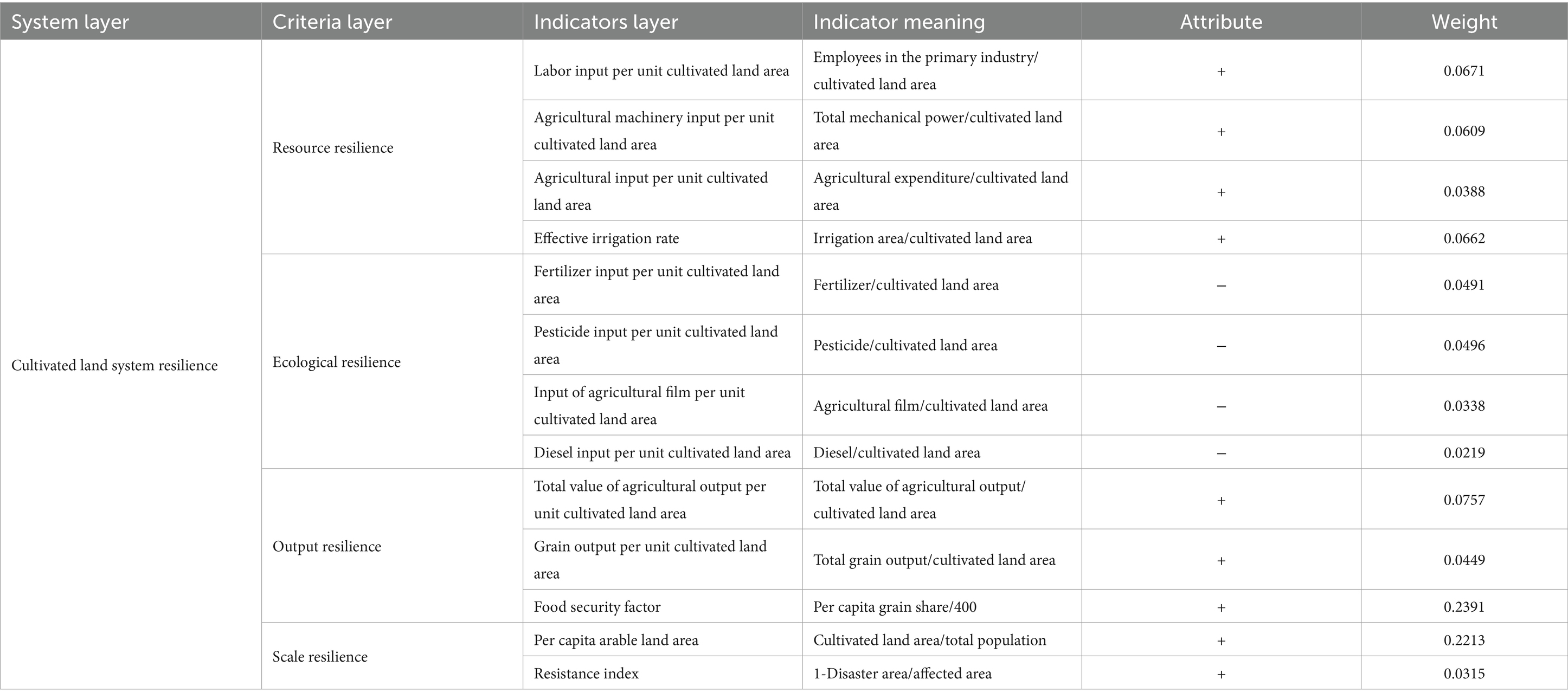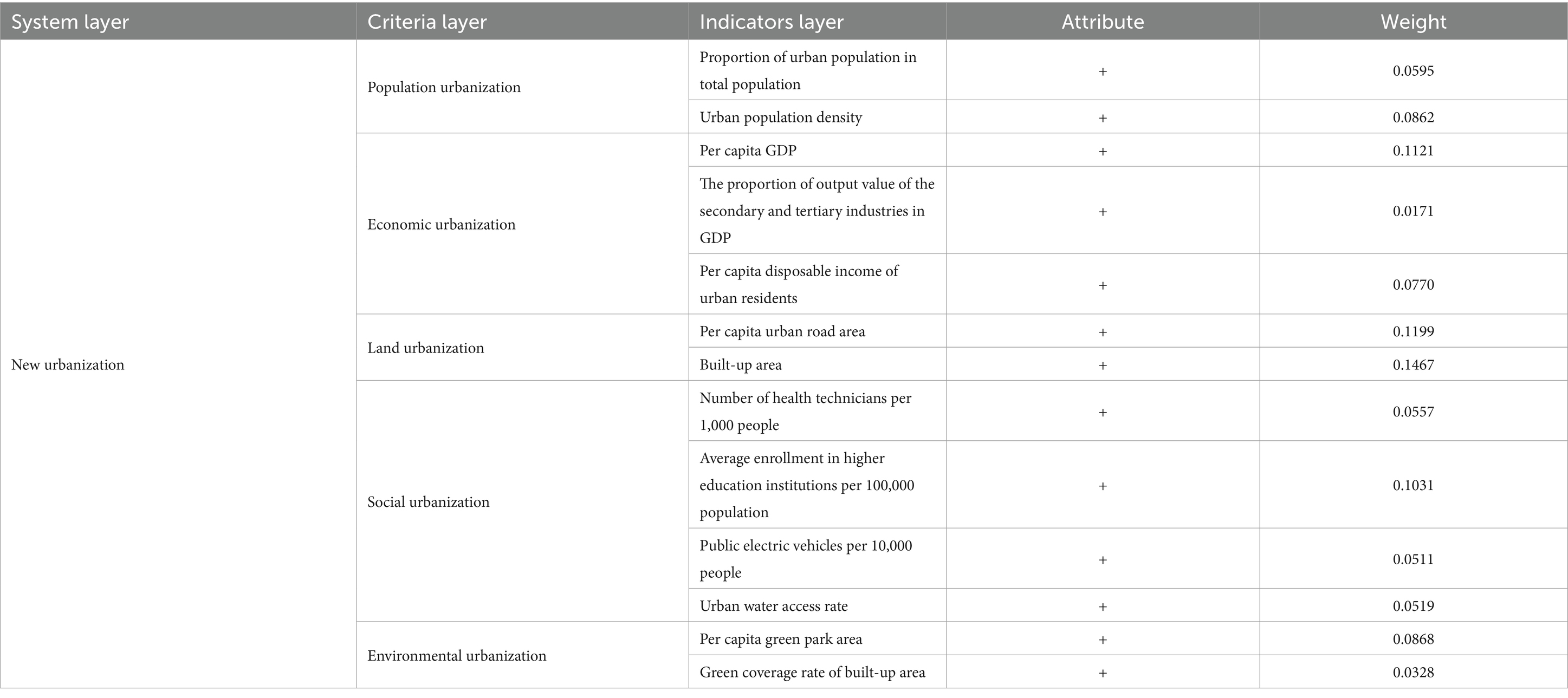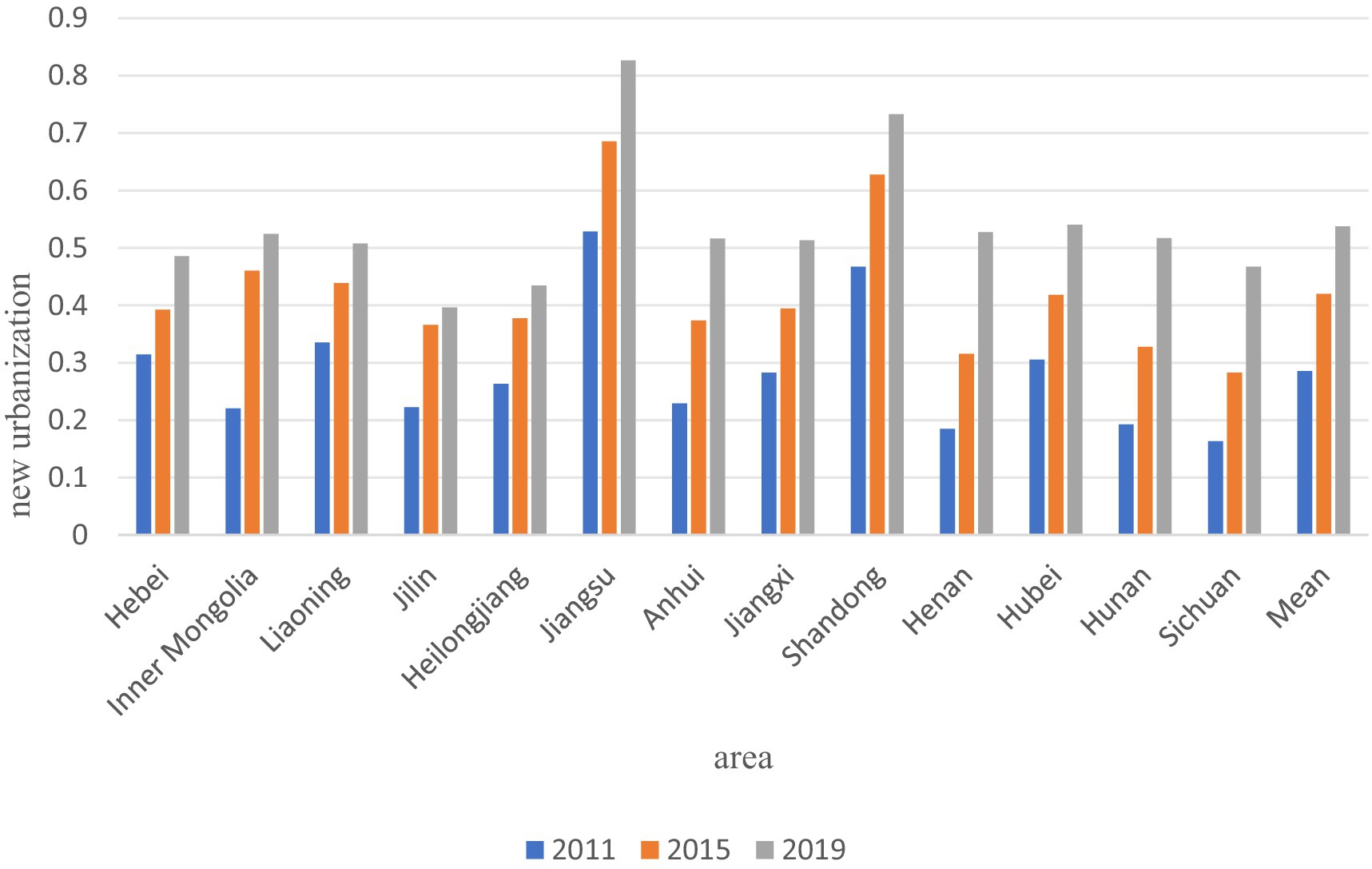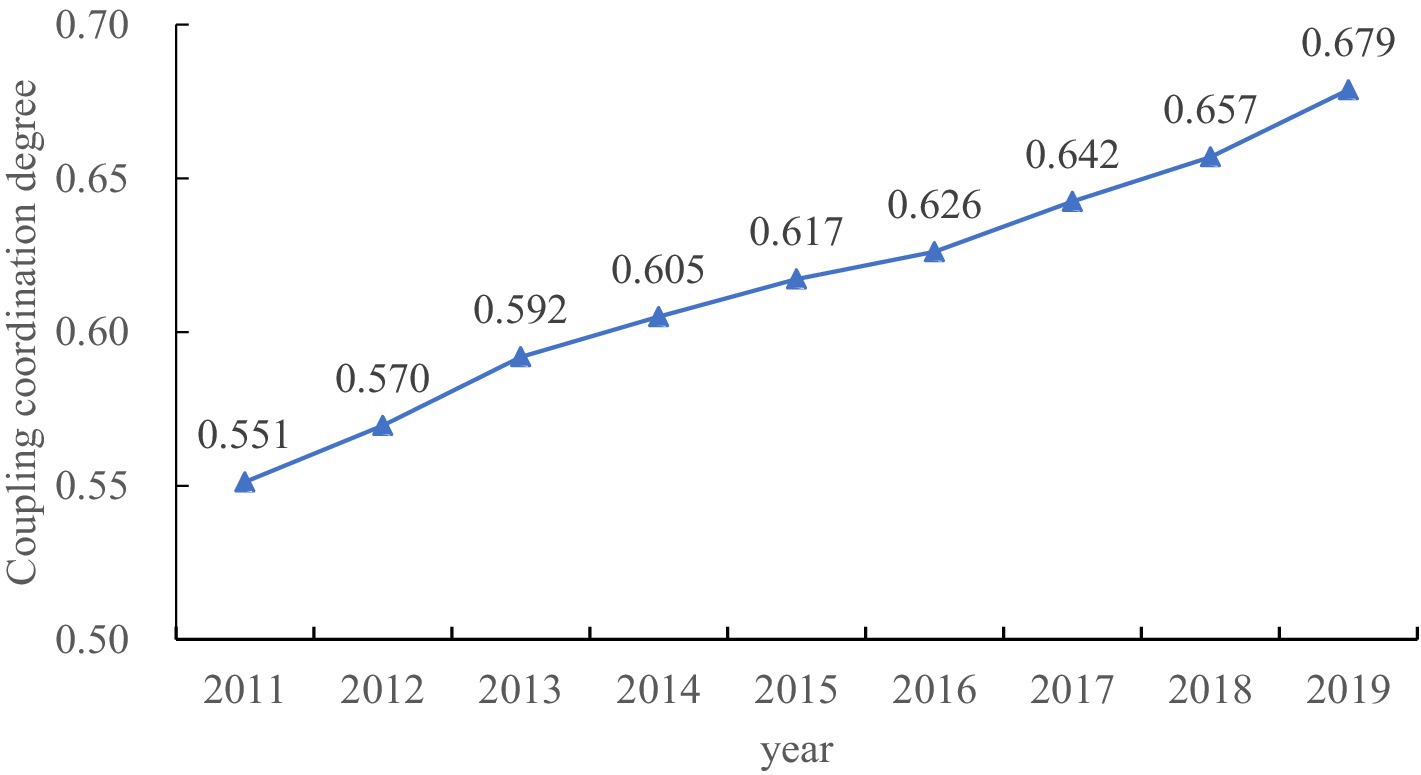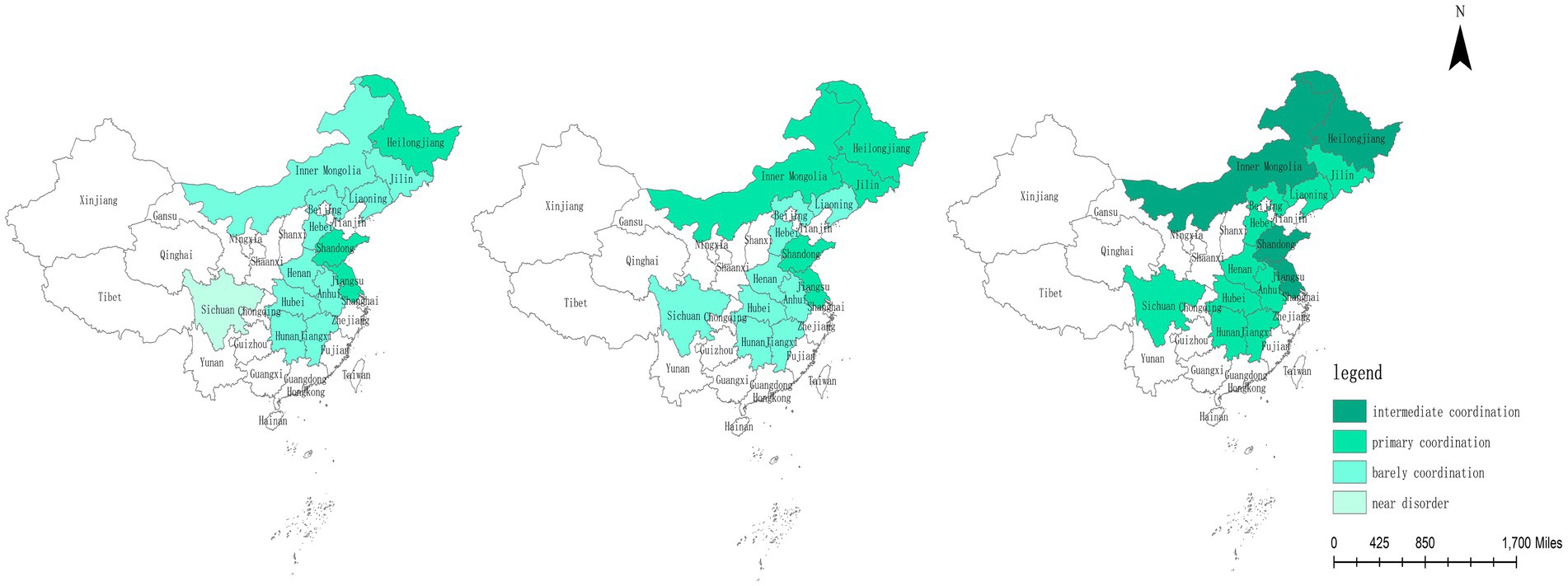- 1School of Economics and Management, Jiangxi Agricultural University, Nanchang, China
- 2School of Economics and Management, Chinese and Law, Shandong Institute of Petroleum and Chemical Technology, Dongying, China
The global food crisis is becoming increasingly severe, highlighting the need to enhance cultivated land system resilience to improve utilization efficiency and strengthen its ability to withstand external shocks, ensuring food security. This study examines 13 major grain-producing areas in China to clarify the coupling coordination mechanism between cultivated land system resilience and new urbanization. An evaluation system is constructed, and development levels are assessed using the entropy method, the coupling coordination degree model, and the obstacle degree model. The main results are as follows: (1) Cultivated land system resilience and new urbanization in China’s major grain-producing areas have exhibited a steady upward trend. (2) The coupling coordination degree has increased from 0.5512 to 0.6788. (3) The primary obstacle factors at the criterion layer are output resilience, scale resilience, and land urbanization. To strengthen the coordination between cultivated land system resilience and new urbanization, policies should be reinforced, the efficiency of cultivated land utilization and agricultural labor productivity should be improved, urbanization planning should be optimized, and regional linkages should be enhanced.
1 Introduction
The United Nations has identified “Ending hunger and achieving food security” as one of the 17 Sustainable Development Goals (SDGs) outlined in its 2030 Agenda for Sustainable Development. However, due to a variety of factors, global food security remains a critical challenge, with hunger persisting in many impoverished regions. According to the 2023 Global Food Crisis Report, more than 250 million people worldwide face severe food insecurity as a result of food shortages. Mitigating the global food crisis is an urgent international priority. The 2023 State of Food Security and Nutrition in the World, published by the United Nations, calls for “strengthening resilience and eliminating the root causes of food insecurity.”
Multiple factors influence food security, including climate (Lassa et al., 2018), international trade (Ibrahim et al., 2024), labor availability (Tinusha and Soumya, 2023), land policies (Martinez et al., 2023), biofuel production (Martínez-Jaramillo et al., 2019), access to land and water resources (Williams, 2015) and urban expansion (Bren d’Amour et al., 2017; Wang et al., 2019; Hou et al., 2019). As the foundation of food security, the cultivated land system plays a crucial role. However, global cultivated land is increasingly affected by soil degradation, and the per capita arable land availability continues to decline. The United Nations Convention to Combat Desertification predicts that by 2050, soil degradation could result in the loss of food production, ecosystem services, and income worth approximately $23 trillion globally. In addition, a 2021 report by the Food and Agriculture Organization (FAO) indicates that between 2000 and 2017, global per capita arable land decreased by 20%. This degradation of land resources and declining per capita farmland availability pose significant threats to global food production.
China’s Ministry of Natural Resources has emphasized that agricultural land management is a fundamental strategic priority for ensuring national food security. As a major grain-producing country, China is committed to collaborating globally to strengthen land protection measures. However, external uncertainties, as well as industrialization and urbanization, have introduced increasing risks to the quantity and ecological sustainability of cultivated land (Verhoeve et al., 2015). In response, resilience theory has increasingly been applied to cultivated land system research, emphasizing the need to enhance land resilience (Calo et al., 2021). Urbanization, in particular, is an important factor affecting land utilization (Zhao D. et al., 2024; Zhao S. et al., 2024). Harmonizing cultivated land system resilience with urbanization dynamics is essential for achieving sustainable food security.
2 Literature review
Holling (1973) first introduced the concept of resilience into the study of ecosystems, analyzing the system’s ability to self-recover after external shocks. Over time, this concept has been extended to various fields, including regional economic resilience (Zhao D. et al., 2024; Zhao S. et al., 2024), socio-ecological resilience (Greene et al., 2022; Asghar et al., 2025), agricultural resilience (Neyra et al., 2025; Tittonell, 2020), and land utilization system resilience (Yin et al., 2024). Due to challenges posed by climate change and economic growth, cultivated land is increasingly under threat, necessitating the analysis of land system resilience from both static and dynamic perspectives (Wang D. et al., 2024; Wang Y. et al., 2024). Resilience not only encompasses recovery but also includes adaptability and transformation (Li et al., 2021). Cultivated land system resilience refers to the system’s ability to reorganize its elements and achieve a new state of equilibrium after internal and external disturbances. Enhancing cultivated land system resilience contributes to the sustainable utilization of agricultural land and ensures food security (Lijun et al., 2019; Wang D. et al., 2024; Wang Y. et al., 2024), making it an important component of sustainable agricultural development (Volkov et al., 2022).
With the global push toward urbanization, the “World Cities Report 2022: Looking Forward to the Future of Cities” estimates that the global urban population will rise from 56% in 2021 to 68% by 2050. In China, the urbanization rate increased from 17.92% in 1978 to 60.60% in 2019 (Hou et al., 2019). Urban expansion is positively influenced by factors such as GDP growth, population density, and capital investment. However, given finite resources, urbanization inevitably interacts with cultivated land systems, particularly through competition for labor, land, and public services. Therefore, further research is needed to analyze the relationship between new urbanization and cultivated land systems to facilitate more coordinated development.
The evaluation of cultivated land system resilience mainly employs a multi-index approach, encompassing resource resilience, ecological resilience, production resilience, structural resilience, and economic resilience (Lyu et al., 2021; Xu et al., 2023). However, research on the coupling correlation between cultivated land system resilience and new urbanization remains limited. Some studies suggest that urbanization negatively impacts cultivated land utilization due to a decline in cultivated land area, leading to its marginalization (Liu et al., 2016). By 2030, urban expansion is projected to result in a loss of 1.8 to 2.4% of global arable land, with particularly severe effects in Asia and Africa (Bren d’Amour et al., 2017). In contrast, other studies argue that urbanization has a positive impact on the intensive use, scale efficiency, and quality enhancement of cultivated land (Yang et al., 2023).
The concept of new urbanization, introduced in the report to the 18th National Congress of China, seeks to advance sustainable urban development by creating more livable, efficient, and environmentally friendly cities. Unlike traditional urbanization, new urbanization focuses on the integration and coordinated development of human settlements, land use, society, economy, and ecological systems. Although existing studies have developed index systems, gaps remain in the analysis of coupling mechanisms and the degree of coupling coordination between cultivated land system resilience and new urbanization. Understanding these mechanisms will provide insights into function relationships while coupling coordination analysis will help assess the current operational status of these systems.
In terms of research methods, most studies have focused on single-dimension coupling coordination evaluations, while the integration of the obstacle degree model remains underdeveloped. Combining multiple models can enhance the depth of research on the relationship between these two systems, providing a more robust scientific basis for their coordination and improvement.
The objectives of this study are as follows: (1) Clarifying the coupling mechanism between cultivated land system resilience and new urbanization, (2) Developing an index evaluation system for cultivated land system resilience and new urbanization, and (3) Measuring the coupling coordination degree and propose improvement strategies to mitigate obstacles, thereby promoting positive interactions between cultivated land system resilience and new urbanization. The framework of this study is illustrated in Figure 1.
3 Theoretical analysis
3.1 Coupling coordination mechanism between cultivated land system resilience and new urbanization
In physics, coupling refers to the interaction between two or more systems, with the degree of coupling reflecting their interdependence (Geng et al., 2020). Coupling coordination refers to a state in which multiple systems interact synergistically to achieve a stable and mutually beneficial relationship (Xing et al., 2019; Görg et al., 2019). Due to the intrinsic linkages between new urbanization and cultivated land system resilience, these two systems are strongly correlated through the dynamic flow of interdependent factors (Ning et al., 2024; Chen et al., 2024). This study examines the coupling coordination mechanism between cultivated land system resilience and new urbanization, focusing on the interactions driven by the exchange of key elements.
New urbanization represents a contemporary approach to urban development (Li et al., 2024). The expansion of new urbanization influences cultivated land system resilience by altering resource allocation. Population urbanization, as explained by migration theory, drives rural populations to relocate to cities, leading to a decline in agricultural labor (Xie et al., 2022). The Lewis Model elaborates on this labor migration from rural to urban areas in developing countries (Kimura and Chang, 2017), illustrating how reductions in agricultural labor affect the resource stability of cultivated land systems. Economic urbanization, driven by the growth of secondary and tertiary industries and rising urban incomes, further widens the rural–urban income gap, accelerating the transfer of agricultural labor to urban areas (Yu and Lu, 2021; Gao et al., 2019). Per capita GDP, an important indicator of economic growth, plays a crucial role in agricultural infrastructure development. Urban expansion promotes land urbanization, leading to the conversion of cultivated land and the significant depletion of China’s agricultural resources. The reduction in farmland and agricultural labor decreases land use intensity, resulting in a shift toward more intensive and efficient agricultural practices. These changes impact both the ecological and output resilience of cultivated land systems (Zhou et al., 2024; Sun et al., 2023; Liu et al., 2024; Wu et al., 2023). Social urbanization, driven by improvements in education, enhances public awareness of sustainable agricultural practices. Higher education stimulates technological innovation and develops skilled labor, supporting the efficient use of cultivated land. The widespread adoption of agricultural machinery further improves land utilization efficiency and grain production (Shehzad and Xue, 2024; Wei and Lu, 2024). Environmental urbanization, which includes the expansion of green spaces and regional parks, alters land availability and usage patterns. Changes in the spatial distribution of cultivated land resources influence grain total factor productivity (Qie et al., 2023).
Evaluating cultivated land system resilience is essential for effective land management and improved land resource utilization. Changes in cultivated land system resilience, in turn, influence the trajectory of new urbanization. Cultivated land system resilience in major grain-producing areas consists of four key aspects: resource resilience, ecological resilience, output resilience, and scale resilience. Resource and scale resilience are crucial for ensuring food security, as national policies regulating the conversion of cultivated land help mitigate urban expansion (Alkhaja et al., 2025; Qie et al., 2023). Scale resilience enhances the capacity of farmland to withstand natural disasters and climate change, ensuring stable food production while supporting new urbanization. Efficient land use management optimizes resource allocation, enabling controlled urbanization while safeguarding agricultural viability. Output resilience, measured by agricultural output value, grain yield, and food security, is an important determinant of global food security (Cheng et al., 2025). The economic value of agricultural output directly influences farmer incomes, which in turn affects migration patterns. When agricultural income is insufficient, rural labor migration to cities intensifies, further accelerating urbanization. However, excessive labor outflow can negatively impact grain production, posing risks to food security. Sustainable new urbanization strategies must therefore balance agricultural and non-agricultural labor distribution. Agricultural labor surplus contributes to the transition of labor from the agricultural sector to other industries (Jorgenson, 1961). Strengthening output resilience enables cultivated land to sustain high productivity levels, reducing yield fluctuations caused by external shocks. This stability secures farmers’ incomes, enhances their purchasing power, and stimulates economic urbanization. Ecological resilience is another essential component, as agricultural input factors such as fertilizers increase grain output but may also lead to environmental pollution, potentially hindering urbanization processes. Prioritizing ecological resilience aligns with sustainable development goals. The adoption of organic fertilizers can reduce environmental degradation while accelerating the transition to more resource-efficient and sustainable agricultural systems (Ejigu and Yeshitela, 2024).
The analysis of the coupling mechanism reveals a strong correlation between cultivated land system resilience and the development of new urbanization. Effective coordination of this relationship is crucial for ensuring food security and advancing sustainable economic development. The framework illustrating the coupling mechanism between cultivated land system resilience and new urbanization is presented in Figure 2.
3.2 Index system construction
3.2.1 Cultivated land resilience index
Evaluating cultivated land system resilience is essential not only for effective land resource management but also as a key indicator of resource utilization efficiency. The impact of cultivated land use should be assessed from economic, social, and ecological perspectives to ensure environmental protection and food security. Resource endowment and necessary resource inputs are crucial driving forces in the transformation of cultivated land systems (Gong et al., 2019). Therefore, the evaluation of cultivated land system resilience should integrate the concept of resilience and the comprehensive assessment of input and output factors. When these factors reach an optimal state, cultivated land management becomes more resilient to external disturbances (Lyu et al., 2021).
The 2023 No. 1 document of the Central Committee emphasizes food security as a primary objective of China’s agricultural policy. It calls for stabilizing cultivated land areas while addressing the carrying capacity of agricultural resources and ensuring environmental security. This study builds on previous research (Yin et al., 2024; Lyu et al., 2021; Xu et al., 2023) and refines cultivated land system indicators. First, food security is included as a fundamental measure of sustainable food production. Second, disaster mitigation is incorporated as an essential feature of cultivated land resilience, which is assessed using an improved resistance index.
The resilience of cultivated land systems in major grain-producing areas is categorized into four key dimensions: resource resilience, ecological resilience, output resilience, and scale resilience (see Table 1). Resource resilience encompasses the availability and input of essential factors such as labor, agricultural machinery, irrigation, and agricultural materials, all of which are necessary for sustaining agricultural productivity. Ecological resilience reflects the environmental impact of fertilizers, pesticides, agricultural film, and diesel usage. While these inputs contribute to food production, excessive utilization can result in adverse environmental effects, such as soil pollution and ecological degradation (Cheng et al., 2025; Boulanger et al., 2020). This study assesses positive agricultural outputs in terms of output resilience and negative environmental impacts through ecological resilience. Output resilience is measured using indicators such as total agricultural output value, total grain yield, and food security metrics. Scale resilience, on the other hand, represents the quantity and stability of cultivated land, evaluated through per capita cultivated land area and the resistance index.
3.2.2 New urbanization
New urbanization is a complex system shaped by the interaction between economic, social, and ecological factors, requiring a comprehensive assessment of their interrelationships. Based on the national planning framework for new urbanization, key indicators are selected to construct an evaluation system that measures the development level of new urbanization from an integrated perspective encompassing population, economy, land, society, and environment (see Table 2).
4 Data and methods
4.1 Research area and data sources
Ensuring food security has become a global priority. China, which supports nearly one-fifth of the world’s population with less than 9% of the world’s arable land, faces significant challenges in maintaining agricultural sustainability. This study focuses on China’s major grain-producing regions, which serve as a representative case for examining cultivated land system resilience in the context of new urbanization.
In 2003, the Ministry of Finance issued the “Opinions on Several Policy Measures for Reforming and Improving the Comprehensive Development of Agriculture,” identifying 13 provinces as China’s major grain-producing areas: Heilongjiang, Jilin, Liaoning, Hebei, Inner Mongolia, Shandong, Jiangsu, Anhui, Henan, Hunan, Hubei, Jiangxi, and Sichuan. These regions are characterized by fertile soil, abundant water resources, and favorable climatic conditions for large-scale food production. They account for a significant proportion of China’s total grain output and cultivated land area, playing a crucial role in national food security and economic stability. Focusing on these major grain-producing provinces ensures strong representativeness and provides valuable insights for broader policy discussions.
The data used in this study were obtained from the China Rural Statistical Yearbook (2012–2020) and the China Statistical Yearbook (2012–2020).
4.2 Entropy method
The entropy method is utilized to determine the weights of each indicator, ensuring the scientific reliability and accuracy of the evaluation results (Chen and Zhang, 2023). The calculation process involves the following steps:
① Dimensionless processing of indicators
To eliminate the impact of varying measurement units, indicator values are normalized to a range of 0–1. represents the value of the j-th variable for the i-th province in the t-th year. “max” and “min” denote the maximum and minimum values of the sample values, respectively.
② Standardization of raw indicators
Standardized indicator values are obtained using the formula:
③ Calculation of indicator proportions
④ Computation of j-th variable entropy values, k represents the number of sample years, and n represents the number of sample provinces.
⑤ Calculation of the differentiation coefficient
⑥ Determination of j-th variable indicator weights
⑦ Comprehensive evaluation for the i-th province in the t-th year
4.3 Coupling coordination degree model
The coupling degree model assesses the interaction between two systems but does not fully account for their respective development levels. In comparison, the coupling coordination degree model evaluates both the internal structure and interaction of the systems, providing a more comprehensive analysis (Yang et al., 2020). The coupling coordination degree (D) is calculated using the following formulas:
(1) Coupling degree (C)
Where C refers to the degree of coupling between cultivated land system resilience and new urbanization.
(2) Comprehensive harmonization index (T)
Where T denotes the overall synergy between the two systems; U1 and U2 are the evaluation indexes for cultivated land system resilience and new urbanization. They are calculated according to Equations 1–8, respectively. The parameters a and b are assigned values of 0.5, assuming equal importance for both systems.
(3) Coupling coordination degree
Where D represents the coupling coordination degree within the range [0,1], reflecting the extent of coordination between the two systems.
The coordination level is classified into ten categories based on D, with each 0.1 interval defining a different level. The classification includes extreme disorder, severe disorder, moderate disorder, mild disorder, near disorder, barely coordination, primary coordination, intermediate coordination, good coordination, and high-quality coordination. A higher D value indicates a greater degree of system coordination.
4.4 Obstacle degree model
The obstacle degree model measures the extent to which certain factors within the index system restrict system development. The model can be used to identify the key factors affecting the coupling coordination between cultivated land system resilience and new urbanization at the criterion and index levels (Yue et al., 2022). The calculation process involves three steps:
(1) Index Deviation degree (Atij)
(2) Factor obstacle degree of the indicator layer (Btij)
(3) Factor obstacle degree of the criterion layer (Ctij)
5 Results
5.1 The level of cultivated land system resilience
The entropy method was applied to evaluate the weight and development level of cultivated land system resilience in major grain-producing areas, both as a whole and at the provincial level, from 2011 to 2019. The assessment considered the four key aspects: resource resilience, ecological resilience, output resilience, and scale resilience. The results are shown in Figure 3.
Overall, the mean resilience level in the 13 major grain-producing areas increased from 0.346 in 2011 to 0.410 in 2019. While minor fluctuation occurred from 2011 to 2015, the resilience level increased significantly between 2016 and 2019. This upward trend is closely linked to China’s protection policies on cultivated land. In 2015, the Ministry of Agriculture launched the “weight loss and drug reduction” initiative. In 2018, the No. 1 document of the Central Committee emphasized the “in-depth implementation of the strategy of storing grain in the land and storing grain in technology, strictly observing the red line of cultivated land, and steadily improving the quality of cultivated land.” The No.1 Central document in 2019 further reinforced this commitment, highlighting the importance of “strictly observing the red line of cultivated land.” These policies have been instrumental in safeguarding cultivated land resources and ensuring ecological stability.
At the provincial level, the 13 provinces exhibited varying degrees of improvement, with Heilongjiang achieving the highest resilience level, reaching 0.683 in 2019. As China’s largest grain-producing province, Heilongjiang has an absolute advantage in cultivated land area and grain output. In 2019, the cultivated land area of Heilongjiang Province was 17.20 million hectares, and the per capita grain output was 1,994 kilograms, ranking first in the country. Heilongjiang’s effective utilization of its resource advantages and implementation of intensive land management practices have significantly contributed to enhancing cultivated land system resilience. Similarly, the resilience levels of Jilin Province and Inner Mongolia exceeded the national average. In comparison, Liaoning Province exhibited a lower cultivated land system resilience score, recording 0.3195 in 2019. Excessive use of agricultural plastic films and pesticides has resulted in the region’s low ecological resilience.
5.2 The level of new urbanization
Based on the five dimensions of population, economic, social, land, and environmental urbanization, the index weights and development level of new urbanization in major grain-producing areas from 2011 to 2019 were evaluated using the entropy method. The results are shown in Figure 4.
Overall, the mean level of new urbanization in the 13 major grain-producing areas steadily increased. The development index of new urbanization rose from 0.286 in 2011 to 0.538 in 2019. Compared with the improvement in cultivated land system resilience, the rate of new urbanization growth was higher. The National New Urbanization Plan (2014–2020), China’s first national urbanization plan, played a key role in accelerating the development of new urbanization in China.
At the provincial level, Jiangsu and Shandong exhibited higher levels of new urbanization compared to the regional average. In contrast, Jilin Province recorded a relatively low level of new urbanization, reaching 0.397 in 2019, which was below the regional average. Jilin’s economic structure remains heavily reliant on heavy industry, which has hindered the advancement of new urbanization.
5.3 Evolution of coupling coordination degree
5.3.1 Analysis of evolution of coupling coordination degree
From the mean values of the 13 major grain-producing areas, the coupling coordination degree between cultivated land system resilience and new urbanization increased annually from 0.551 to 0.679 between 2011 and 2019 (see Figure 5). Coupling coordination degree are calculated according to Equations 9–11, respectively. Further analysis by time period indicates that the average coupling coordination degree between the two systems was classified as barely coordinated from 2011 to 2013 (0.551–0.592). On the one hand, extensive cultivation methods remained largely unchanged; on the other hand, early urbanization was still primarily driven by land expansion. From 2014 to 2019, the coupling coordination entered the primary coordination stage (0.605–0.679). This suggests that the relationship between new urbanization and cultivated land system resilience has improved, largely due to national and provincial policies. However, compared to a high-quality coordination state (0.9–1), there remains substantial room for further enhancement.
Table 3 shows the specific values. Overall, the coupling coordination degree across provinces has demonstrated a discernible improvement. In 2011, only Heilongjiang, Jiangsu, and Shandong had reached the primary coordination state. By 2019, this number had increased to nine provinces. However, only Inner Mongolia, Heilongjiang, and Shandong had reached the intermediate coordination state. Further improvements are necessary to enhance the coupling coordination in the major grain-producing areas. Identifying and addressing the factors that hinder further progress will be essential for promoting the coordinated development of cultivated land system resilience and new urbanization.
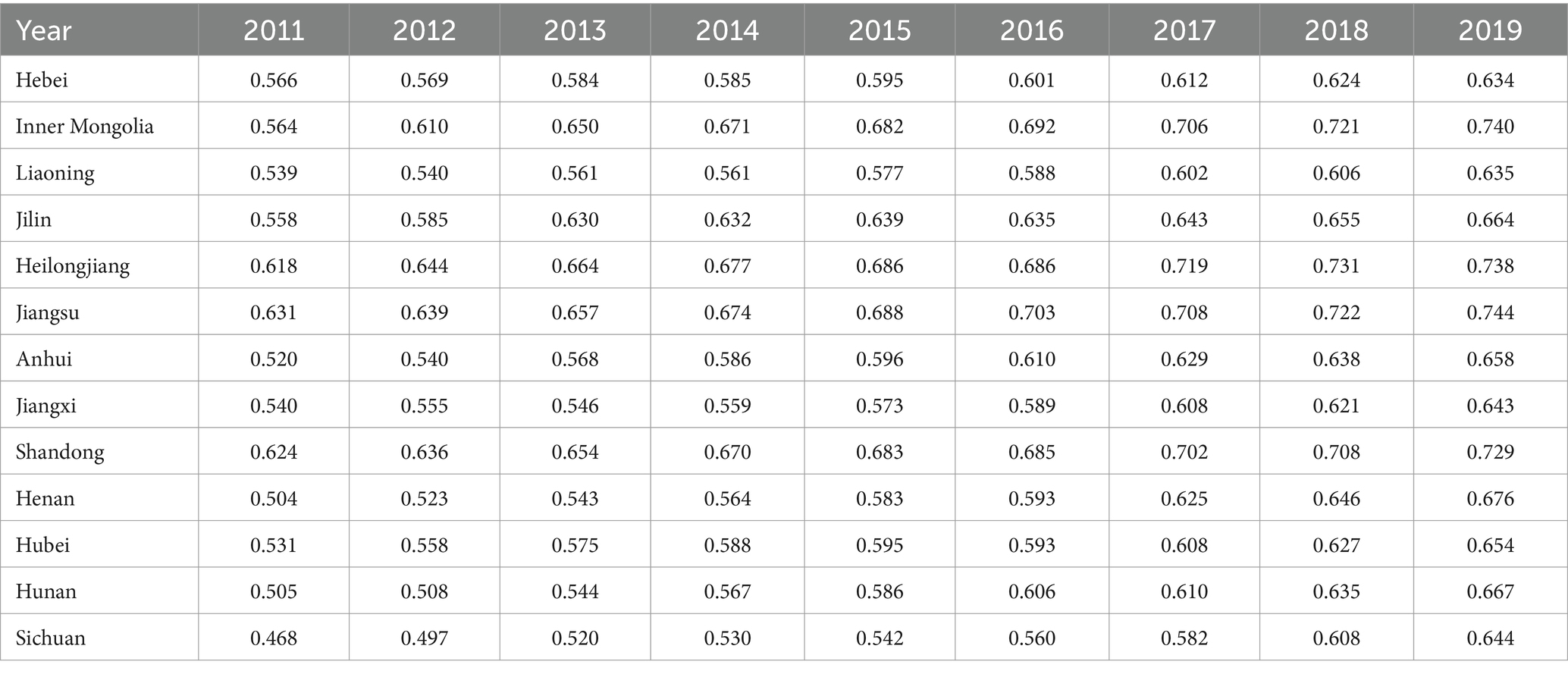
Table 3. Coupling coordination degree between cultivated land system resilience and new urbanization from 2011 to 2019.
5.3.2 Visualization of spatial evolution of coupling coordination degree
ArcGIS software was used to analyze the spatial distribution of the measured results. The coupling coordination degree between cultivated land system resilience and new urbanization was visualized based on classification criteria (see Figure 6). Analysis of changes across the three time periods (2011, 2015, and 2019) indicates a growing number of provinces reaching the primary coordination stage, while regional differences in coupling coordination degree have decreased. In 2011, only Heilongjiang, Jiangsu, and Shandong had entered the primary coordination stage, while the other provinces remained in the barely coordinated stage. By 2019, all provinces had advanced by one level, transitioning from barely coordinated to primary coordination, or from primary coordination to intermediate coordination. Inner Mongolia showed the most significant improvement, progressing from barely coordinated to intermediate coordination. In 2019, Inner Mongolia, Heilongjiang, Jiangsu, and Shandong had reached the intermediate coordination stage.
The growth in coupling coordination has been strongly influenced by local resources and policy support. For example, Heilongjiang Province, which has the largest cultivated land area in China, benefits from favorable conditions for large-scale agricultural development. This advantage allows for better coordination between cultivated land use and new urbanization, providing resource support for land urbanization while ensuring cultivated land resilience. In addition, China has promoted the construction of water conservancy projects and high-standard farmlands to improve agricultural resilience against natural disasters and improve their overall production capacity.
5.4 Obstacle factors that affect coupling coordination degree
Analysis using the entropy method and coupling coordination model reveals significant differences between cultivated land system resilience and new urbanization in major grain-producing areas. Moreover, most provinces have substantial room for enhancing high-quality coordination. Identifying the major obstacle factors affecting the coupling coordination of these two systems is therefore essential. The obstacle degree model was applied to analyze these factors, selecting the top three at the criterion layer and the top five at the index layer. The results are presented in Tables 4, 5. They are calculated according to Equations 12–14, respectively.
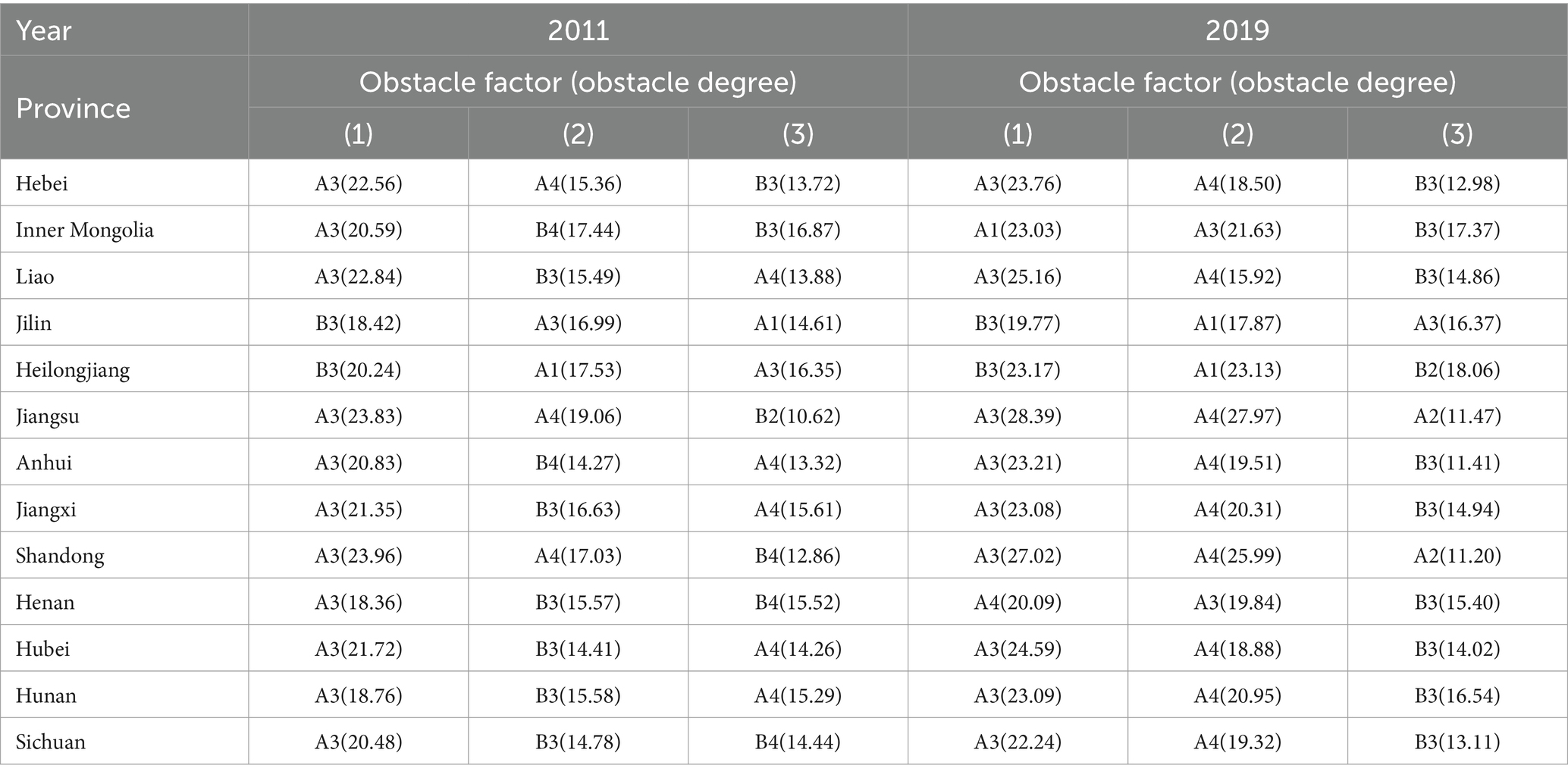
Table 4. Main obstacle factors of cultivated land system resilience and new urbanization at the criterion level in 2011/2019.
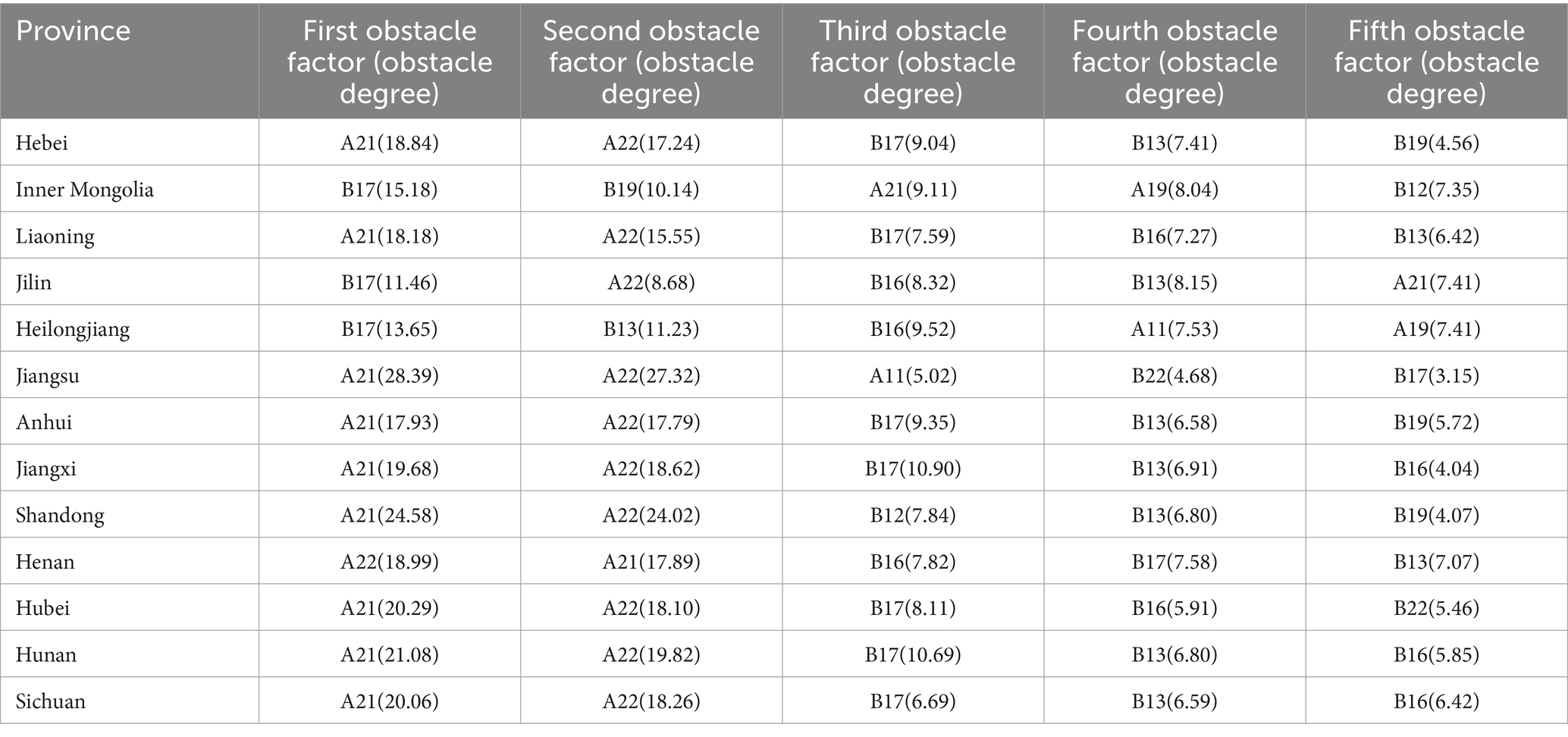
Table 5. The main obstacle factors of cultivated land system resilience and new urbanization at the index level in 2019.
5.4.1 Analysis of criterion layer obstacle factors
Resource resilience, ecological resilience, output resilience, and scale resilience were designated as A1, A2, A3, and A4, respectively. Population urbanization, economic urbanization, land urbanization, social urbanization, and environmental urbanization were labeled as B1, B2, B3, B4, and B5. As shown in Table 4, the primary obstacle factors affecting the coupling coordination degree in 2011 and 2019 were A3 (output resilience), A4 (scale resilience), and B3 (land urbanization), indicating that most provinces faced common challenges.
The theory of land scarcity suggests that land use competition creates trade-offs between different purposes (He et al., 2024). In cultivated land resource resilience and land urbanization, land serves as a critical resource input. Given its limited availability, allocation for one purpose often reduces its availability for another. Addressing these conflicts requires optimal land-use planning and improved efficiency. The prominence of cultivated land area-related factors among the top three obstacles further supports the theory of land scarcity.
In the analysis of barrier factors, B5 (environmental urbanization) was absent from the top three obstacle factors, suggesting that national policies promoting green urban development have yielded considerable results. However, in 2019, A2 (ecological resilience) emerged as an increasing concern in Jiangsu and Shandong, highlighting the need for better management of pesticides, fertilizers, and agricultural films to enhance cultivated land resilience in these provinces.
5.4.2 Analysis of index layer obstacle factors
Identifying obstacle factors in the coupling coordination degree solely at the criterion layer may obscure individual differences among sub-indicators. Therefore, given the similarity of major obstacle degrees at the criterion layer in both years, a more detailed subdivision of the index layer for 2019 was conducted. The top five most important factors were selected for in-depth analysis (see Table 5).
Indicators of cultivated land system resilience were denoted as A11-A23, while indicators of new urbanization were represented as B11-B23. The analysis shows that, in most provinces, the primary obstacle factors at the index level in 2019 were food security (A21), per capita cultivated land area (A22), and built-up area (B17). These three sub-indicators correspond to A3, A4, and B3 in the criterion layer.
In Heilongjiang, the top three obstacle factors were concentrated in the new urbanization system, including per capita GDP(B13), per capita urban road area (B16), and built-up area (B17). This suggests that while Heilongjiang demonstrated strong cultivated land system resilience, further optimization is required for new urbanization development. For Inner Mongolia, the province needs to focus on addressing its higher education problems and strengthening the education of its high-level talents. Expanding the analysis to the top five factors, per capita GDP (B13) was a common obstacle factor in most provinces, while other factors varied. For example, per capita urban road area (B16) and the average number of students in higher education schools per 100,000 population (B19) were considerable obstacle factors in certain provinces.
The analysis of obstacle factors at the criterion layer and index layer suggests that the core factors affecting the coupling coordination degree between cultivated land system resilience and new urbanization primarily involve land and labor resources, as well as grain output. Per capita grain consumption, a key measure of food security, is directly dependent on land and labor inputs. While different factors influence coordination in different years, the advancement of urbanization must not come at the expense of agricultural land loss. The 1.8 billion mu of cultivated land red line, set by the Chinese government, must be strictly upheld. Moreover, per capita GDP, as an indicator of regional economic development, plays a crucial role. Limited economic growth can constrain investments in both cultivated land system resilience and new urbanization development.
6 Discussion
The coordination of urbanization and cultivated land use is essential for the balanced development of urban and rural areas (Wei and Lu, 2024). The interaction between cultivated land system resilience and new urbanization affects food security, as both systems involve the mutual flow of factors (Lee et al., 2024). Given the volatile external environment, research on cultivated land system resilience has become increasingly urgent (Li et al., 2025). Exploring the coupling coordination degree between these two systems, as well as its spatio-temporal evolution, obstacle factors, and development countermeasures, offer theoretical insights and practical guidance for enhancing cultivated land system resilience and promoting new urbanization.
This study constructs a theoretical framework to analyze the coupling coordination between cultivated land system resilience and new urbanization while systematically outlining their coordination mechanisms. Using data from 13 major grain-producing provinces (2011–2019), this study examines the coupling coordination degree and its spatio-temporal evolution by integrating the entropy method and the coupling coordination model. In addition, the obstacle degree model is employed to identify key barriers affecting the coordination of these systems.
6.1 The relationship between cultivated land system resilience and new urbanization
From a coupling and coordination perspective, the factors influencing cultivated land system resilience and new urbanization in major grain-producing areas interact dynamically. Given limited resources, the relationship between these two systems often presents contradictions; however, their mutual influence is also a key drive of coordinated development. Effective coordination among the various elements is essential to maintaining the stability of cultivated land system resilience, ensuring food security, and supporting the sustainable development of new urbanization. Song and Tao (2022) also emphasized the importance of coupling and coordination between cultivated land use and urbanization. Examining the theoretical influence mechanisms behind this interaction provides a deeper understanding of the underlying factors shaping their relationship.
6.2 Progress in cultivated land system resilience, new urbanization, and coupling coordination
In China’s major grain-producing areas, both cultivated land system resilience and new urbanization have exhibited upward trends. The cultivated land system resilience index rose from 0.346 to 0.410, with Heilongjiang reaching the highest level of 0.683 in 2019. The development level of new urbanization increased from 0.286 to 0.538, growing at a faster rate than cultivated land system resilience. The coupling coordination degree between new urbanization and cultivated land system resilience also showed an overall steady growth, increasing from 0.5512 to 0.6788. Across the entire region, the coordination level improved from barely coordinated to primary coordination, with some provinces reaching intermediate coordination. And while the number of provinces with a high coordination degree increased, spatial imbalances in development persist.
The concept of new urbanization emphasizes the “two-way” agglomeration of factors in rural areas and cities, which can alleviate shortages caused by the unidirectional movement of certain factors (Zhou et al., 2024). This aligns with the findings of this paper, which emphasize that strengthening coupling coordination and fostering the convergence of key elements are essential for balancing cultivated land system resilience with urbanization. Such coordination is crucial for safeguarding food security and sustainable economic development. Despite continuous improvements in coupling coordination, the overall level remains relatively low, indicating the presence of underlying factors that impede fully integrated development.
6.3 Commonalities in obstacle factors across major grain-producing areas
The analysis using the obstacle degree model shows that major grain-producing areas share common obstacle factors affecting the coupling coordination degree. At the criterion layer, the top three obstacle factors are mainly concentrated in output resilience, scale resilience, and land urbanization. At the index layer, the most significant barriers include per capita food security rate, per capita cultivated land area, and built-up area.
Beyond these shared challenges, some obstacle factors vary by province. For instance, per capita GDP, higher education student enrollment, and per capita urban road area are significant in particular provinces and should be addressed based on each province’s specific conditions. Previous studies have highlighted similar barriers. For example, the uncoordinated coupling relationship between population, land, and food has been identified as a key factor affecting food security (Liu et al., 2024). Other research has found that soil erosion, per capita cultivated land area, and per capita grain output are major obstacles to the ecological security of cultivated land use (Jing et al., 2024). In addition, transportation infrastructure and economic development have been found to influence agricultural resilience and productivity (Zhang et al., 2023), while GDP growth and population density can influence the expansion of land urbanization (Wu and Li, 2020).
6.4 Policy implications
The gradual improvement in the coupling coordination degree suggests that national policies on cultivated land protection and new urbanization have played a significant role in promoting sustainable development. Food security is fundamental not only for human survival but also for social stability and economic progress. According to the land scarcity theory, the limited availability of land necessitates strategic policies to ensure its optimal use for food production (Calo et al., 2021). Policies such as land property regimes can help safeguard cultivated land’s role in ensuring food output. In addition, land ownership confirmation has been shown to facilitate agricultural land transfers, contributing to economies of scale and improved land utilization (Qiu et al., 2020). It is crucial to strictly implement policies ensuring the balance of land occupation and compensation, eliminating practices such as “occupying the superior and compensating the inferior” or “accounting for more and compensating the less.” These measures will help maintain both the quantity and quality of cultivated land. Research suggests that a well-structured land use system can enhance resilience to external shocks (Chen et al., 2019).
The analysis of obstacle factor analysis highlights land and labor force as core determinants in the coordination between cultivated land resilience and new urbanization. Despite significant progress, developing countries still have substantial potential for improving land resources and agricultural productivity. Given that land is both scarce and non-renewable, efficient and intensive land use is essential. A policy-driven, goal-oriented agricultural land profit-and-loss assessment framework (Qie et al., 2023) can guide rational land utilization by achieving a dynamic balance of cultivated land use. Fertilizer, machinery, and pesticide inputs should be strategically planned alongside cultivated land protection objectives. The adoption of mechanized farming techniques can boost food production and mitigate disaster losses, with more pronounced benefits for individuals with higher education levels and lower incomes (Fang et al., 2024; Song et al., 2025). Monitoring the land system and developing a comprehensive land protection strategy is necessary to strengthen cultivated land system resilience (Wang D. et al., 2024; Wang Y. et al., 2024). Additionally, raising awareness of cultivated land protection is crucial. Land use patterns should be carefully planned to avoid fragmentation caused by uncoordinated expansion of urban land and other land uses. Implementing farmer support policies and agricultural subsidies can encourage active land cultivation. Moreover, improving the skills of the rural labor force is essential. Marshall focused on the long-term benefits of investing in human capital, and improving rural labor skills can significantly boost productivity. In China, the increase in total grain output is primarily due to advancements in agricultural technology. Harnessing technology-driven urbanization, encouraging rural labor workers to adopt modern agricultural techniques, and optimizing agricultural production and management practices will be key to sustaining growth.
7 Conclusion
This study examines the interaction between cultivated land system resilience and new urbanization, driven by the flow of various elements. By organizing these elements at a theoretical level, this study explores the coupling mechanism between the two systems, incorporating relevant economic theories to explain how factor flow influence their interaction. Using the entropy method, coupling coordination degree model, and obstacle degree model, this study quantitatively assesses the development level, coupling coordination degree, and key obstacles affecting the resilience of the cultivated land system and new urbanization.
The results show an increasing trend in both the development level and coupling coordination degree. The resilience level of the cultivated land system increased from 0.346 to 0.410, while the new urbanization development level rose from 0.286 to 0.538. The overall coupling coordination degree increased from 0.5512 to 0.6788, with certain provinces, such as Inner Mongolia, Heilongjiang, Jiangsu, and Shandong, reaching the intermediate coordination level. However, regional disparities remain, with output resilience, scale resilience, and land urbanization identified as the main obstacles to coordinated development.
This study offers several key contributions. First, the concept of resilience is introduced into the study of cultivated land systems, and an evaluation framework is constructed based on resource resilience, production resilience, ecological resilience, and resource resilience. Second, this study adopts a people-oriented perspective in urbanization studies, promoting coordinated development across multiple dimensions. A comprehensive evaluation system for new urbanization is developed, measuring progress in terms of population urbanization, economic urbanization, land urbanization, social urbanization, and environmental urbanization using the entropy method. Third, this study clarifies the coupling mechanism between cultivated land system resilience and new urbanization development, applying the coupling coordination degree model to assess their interrelationship over time. Spatio-temporal patterns and dynamic evolutionary trends are analyzed using ArcGIS spatial visualization. Fourth, the study employs an obstacle model to identify key hindrances to coordinated development, providing insights for improving cultivated land system resilience and guiding sustainable urbanization strategies.
China’s major grain-producing areas serve as the focal point of this study due to their significant share of the country’s cultivated land and grain output. The analysis spans 13 provinces with notable regional variations, offering insights that may apply to developing countries seeking to strengthen cultivated land system resilience and maintain food security while advancing new urbanization.
However, there are also some shortcomings in this study. The data is limited to China’s primary grain-producing areas, and future research should explore spatial spillover effects to better coordinate interactions and regional linkages between new urbanization and cultivated land system resilience across different regions.
Data availability statement
The original contributions presented in the study are included in the article/supplementary material, further inquiries can be directed to the corresponding author.
Author contributions
WL: Methodology, Writing – original draft, Writing – review & editing, Project administration. JG: Conceptualization, Writing – review & editing, Writing – original draft.
Funding
The author(s) declare that financial support was received for the research and/or publication of this article. This study was supported by the following projects: Dongying Science Development Fund Project (DJB2023014).
Acknowledgments
The authors thank the institutions that provided funding. In addition, we are also extremely grateful to the editor and reviewers for their valuable review comments and suggestions. Further, we would like to acknowledge Shuang Hu and Pengcheng Zhang for their assistance in refining the figures.
Conflict of interest
The authors declare that the research was conducted in the absence of any commercial or financial relationships that could be construed as a potential conflict of interest.
Generative AI statement
The author(s) declare that no Gen AI was used in the creation of this manuscript.
Publisher’s note
All claims expressed in this article are solely those of the authors and do not necessarily represent those of their affiliated organizations, or those of the publisher, the editors and the reviewers. Any product that may be evaluated in this article, or claim that may be made by its manufacturer, is not guaranteed or endorsed by the publisher.
References
Alkhaja, N., Alawadi, K., Almemari, K., and Alshehhi, G. (2025). How is urban agriculture practiced, institutionalized, implemented, and sustained? A literature review. Prog. Plan. 192:100917. doi: 10.1016/J.PROGRESS.2024.100917
Asghar, M., Ayaz, M., and Ali, S. (2025). Ecological resilience in crisis: analyzing the role of urban land use and institutional policies. Land Use Policy 151:107492. doi: 10.1016/J.LANDUSEPOL.2025.107492
Boulanger, P., Dudu, H., Ferrari, E., Mainar-Causapé, A. J., and Ramos, M. P. (2020). Effectiveness of fertilizer policy reforms to enhance food security in Kenya: a macro–micro simulation analysis. Appl. Econ. 54, 841–861. doi: 10.1080/00036846.2020.1808180
Bren d’Amour, C., Reitsma, F., Baiocchi, G., Barthel, S., Güneralp, B., Erb, K. H., et al. (2017). Future urban land expansion and implications for global croplands. Proc. Natl. Acad. Sci. 114, 8939–8944. doi: 10.1073/pnas.1606036114
Calo, A., McKee, A., Perrin, C., Gasselin, P., McGreevy, S., Sippel, S. R., et al. (2021). Achieving food system resilience requires challenging dominant land property regimes. Front. Sustain. Food Syst. 5:683544. doi: 10.3389/FSUFS.2021.683544
Chen, Y., Bakker, M. M., Ligtenberg, A., and Bregt, A. K. (2019). External shocks, agent interactions, and endogenous feedbacks-investigating system resilience with a stylized land use model. Ecol. Complex. 40:100765. doi: 10.1016/j.ecocom.2019.04.003
Chen, M., Zeng, L., Deng, Y., Chen, S., and Gu, X. (2024). The impact of land marketization on urban resilience: empirical evidence from Chinese cities. Land 13:1385. doi: 10.3390/LAND13091385
Chen, C., and Zhang, H. (2023). Evaluation of green development level of Mianyang agriculture, based on the entropy weight method. Sustain. For. 15:7589. doi: 10.3390/SU15097589
Cheng, P., Zhang, Y., Liu, K., Kong, X., Wu, S., Yan, H., et al. (2025). Continuing the continuous harvests of food production: from the perspective of the interrelationships among cultivated land quantity, quality, and grain yield. Human. Soc. Sci. Commun. 12:46. doi: 10.1057/S41599-024-04342-1
Ejigu, K. A., and Yeshitela, K. (2024). Exploring the factors influencing urban farmers’ perception and attitude toward the use of excreta-based organic fertilizers in Arba Minch City, Ethiopia. Front. Sustain. Food Syst. 7:1271811. doi: 10.3389/FSUFS.2023.1271811
Fang, D., Chen, J., Wang, S., and Chen, B. (2024). Can agricultural mechanization enhance the climate resilience of food production? Evidence from China. Appl. Energy 373:123928. doi: 10.1016/J.APENERGY.2024.123928
Gao, Y. L., Zhang, Z. Y., Wei, S. H., and Wang, Z. G. (2019). Impact of urbanization on food security: Evidence from provincial panel data in China. Res. Sci. 41, 1462–1474. doi: 10.18402/resci.2019.08.07
Geng, Y., Wei, Z., Zhang, H., and Maimaituerxun, M. (2020). Analysis and prediction of the coupling coordination relationship between tourism and air environment: yangtze river economic zone in China as example. Discrete Dyn. Nat. Soc. 2020:1406978. doi: 10.1155/2020/1406978
Gong, Y., Li, J., and Li, Y. (2019). Spatiotemporal characteristics and driving mechanisms of arable land in the Beijing-Tianjin-Hebei region during 1990-2015. Socio Econ. Plan. Sci. 70, –100720. doi: 10.1016/j.seps.2019.06.005
Görg, F., Sandholzer, K., Minguzzi, J., Desbuquois, R., Messer, M., and Esslinger, T. (2019). Realization of density-dependent Peierls phases to engineer quantized gauge fields coupled to ultracold matter. Nat. Phys. 15, 1161–1167. doi: 10.1038/s41567-019-0615-4
Greene, C., Wilmer, H., Ferguson, D. B., Crimmins, M. A., and McClaran, M. P. (2022). Using scale and human agency to frame ranchers’ discussions about socio-ecological change and resilience. J. Rural. Stud. 96, 217–226. doi: 10.1016/J.JRURSTUD.2022.11.001
He, T., Li, J., Zhang, M., Zhai, G., Lu, Y., Wang, Y., et al. (2024). Uphill cropland and stability assessment of gained cropland in China over the preceding 30 years. J. Geogr. Sci. 34, 699–721. doi: 10.1007/S11442-024-2224-0
Holling, C. S. (1973). Resilience and stability of ecological systems. Annu. Rev. Ecol. Syst. 4, 1–23. doi: 10.1146/annurev.es.04.110173.000245
Hou, X., Liu, J., Zhang, D., Zhao, M., and Xia, C. (2019). Impact of urbanization on the eco-efficiency of cultivated land utilization: a case study on the Yangtze River Economic Belt, China. J. Clean. Prod. 238:117916. doi: 10.1016/j.jclepro.2019.117916
Ibrahim, A. L., Robert, A., and James, M. O. (2024). City governance, urban livelihoods, and food security: insights from street food trade in Kumasi, Ghana. Food Secur. 16, 1081–1098. doi: 10.1007/S12571-024-01486-5
Jing, X., Tao, S., Hu, H., Sun, M., and Wang, M. (2024). Spatio-temporal evaluation of ecological security of cultivated land in China based on DPSIR-entropy weight TOPSIS model and analysis of obstacle factors. Ecol. Indic. 166:112579. doi: 10.1016/J.ECOLIND.2024.112579
Jorgenson, D. W. (1961). The development of a dual economy. Econ. J. 71, 309–334. doi: 10.2307/2228770
Kimura, F., and Chang, S. M. (2017). Industrialization and poverty reduction in East Asia: internal labor movements matter. J. Asian Econ. 48, 23–37. doi: 10.1016/j.asieco.2016.10.005
Lassa, J. A., Teng, P., Caballero-Anthony, M., and Shrestha, M. (2018). Revisiting emergency food reserve policy and practice under disaster and extreme climate events. Int. J. Disaster Risk Sci. 10, 1–13. doi: 10.1007/s13753-018-0200-y
Lee, C. C., Zeng, M., and Luo, K. (2024). The impact of urbanization on food security in China. Int. Rev. Econ. Finance (PB) 93, 1159–1175. doi: 10.1016/J.IREF.2024.05.037
Li, Y., Gao, G., Wen, J., Zhao, N., du, G., and Stanny, M. (2025). The measurement of agricultural disaster vulnerability in China and implications for land-supported agricultural resilience building. Land Use Policy 148:107400. doi: 10.1016/J.LANDUSEPOL.2024.107400
Li, G., Kou, C., and Wen, F. (2021). The dynamic development process of urban resilience: from the perspective of interaction and feedback. Cities 114:103206. doi: 10.1016/J.CITIES.2021.103206
Li, T., Liu, Y., Ouyang, X., Zhou, Y., Bi, M., and Wei, G. (2024). Sustainable development of urban agglomerations around lakes in China: achieving SDGs by regulating ecosystem service supply and demand through new-type urbanization. Habitat Int. 153:103206. doi: 10.1016/J.HABITATINT.2024.103206
Lijun, M., Can, H., Xin, C., Li, J. I. A. N. G., Guoliang, Z. H. A. N. G., Jimin, H., et al. (2019). Evaluation of cultivated land system resilience of Quzhou County. Resour. Sci. 41, 1949–1958. doi: 10.18402/resci.2019.10.16
Liu, D., Liu, W., and He, Y. (2024). How does the intensive use of urban construction land improve carbon emission efficiency?—evidence from the panel data of 30 provinces in China. Land 13:2133. doi: 10.3390/LAND13122133
Liu, G., Wang, H., Cheng, Y., Zheng, B., and Lu, Z. (2016). The impact of rural out-migration on arable land use intensity: evidence from mountain areas in Guangdong, China. Land Use Policy. 59, 569–579. doi: 10.1016/j.landusepol.2016.10.005
Lyu, X., Wang, Y., Niu, S., and Peng, W. (2021). Spatio-temporal pattern and influence mechanism of cultivated land system resilience: case from China. Land 11:11. doi: 10.3390/LAND11010011
Martínez-Jaramillo, J. E., Arango-Aramburo, S., and Giraldo-Ramírez, D. P. (2019). The effects of biofuels on food security: a system dynamics approach for the Colombian case. Sustain Energy Technol Assess 34, 97–109. doi: 10.1016/j.seta.2019.05.009
Martinez, P., Gomes, M. D. L. S., and Marini, F. S. (2023). Public policies strengthen the relationship between family farming and food security in Brazilian schools–a case study of Paraíba state. Heliyon 9. doi: 10.1016/J.HELIYON.2023.E20482
Neyra, V. M. J., Cequea, M. M., and Schmitt, H. G. V. (2025). Current practices and key challenges associated with the adoption of resilient, circular, and sustainable food supply chain for smallholder farmers to mitigate food loss. Front. Sustain. Food Syst. 9:1484933. doi: 10.3389/FSUFS.2025.1484933
Ning, L., Sheng, S., and Meng, Y. (2024). The interplay and synergistic relationship between urban land expansion and urban resilience across the three principal metropolitan regions of the Yangtze River basin. Sci. Rep. 14, –31868. doi: 10.1038/S41598-024-83200-1
Qie, L., Pu, L., Tang, P., Liu, R., Huang, S., Xu, F., et al. (2023). Gains and losses of farmland associated with farmland protection policy and urbanization in China: an integrated perspective based on goal orientation. Land Use Policy 129:106643. doi: 10.1016/J.LANDUSEPOL.2023.106643
Qiu, T., Choy, S. B., Li, S., He, Q., and Luo, B. (2020). Does land renting-in reduce grain production? Evidence from rural China. Land Use Policy 90:104311. doi: 10.1016/j.landusepol.2019.104311
Shehzad, K., and Xue, Q. (2024). Can technology in terms of finance, environment, and communication boost food production while facilitating a low-carbon transition? Evidence from a high-tech and low-tech state. J. Clean. Prod. 477:143859. doi: 10.1016/J.JCLEPRO.2024.143859
Song, H., Li, X., Xin, L., and Wang, X. (2025). Improving mechanization conditions or encouraging non-grain crop production? Strategies for mitigating farmland abandonment in China’s mountainous areas. Land Use Policy 149:107421. doi: 10.1016/J.LANDUSEPOL.2024.107421
Song, M., and Tao, W. (2022). Coupling and coordination analysis of China’s regional urban-rural integration and land-use efficiency. Growth and Change 53, 1384–1413. doi: 10.1111/grow.12625
Sun, X., Li, Q., Kong, X., Cai, W., Zhang, B., and Lei, M. (2023). Spatial characteristics and obstacle factors of cultivated land quality in an intensive agricultural region of the North China plain. Land 12:1552. doi: 10.3390/LAND12081552
Tinusha, G. P. A. H., and Soumya, B. (2023). Migration, gender labor division and food insecurity in Tajikistan. Food Policy 116:102438. doi: 10.1016/J.FOODPOL.2023.102438
Tittonell, P. (2020). Assessing resilience and adaptability in agroecological transitions. Agric. Syst. 184:102862. doi: 10.1016/j.agsy.2020.102862
Verhoeve, A., Dewaelheyns, V., Kerselaers, E., Rogge, E., and Gulinck, H. (2015). Virtual farmland: grasping the occupation of agricultural land by non-agricultural land uses. Land Use Policy 42, 547–556. doi: 10.1016/j.landusepol.2014.09.008
Volkov, A., Morkunas, M., Balezentis, T., and Streimikiene, D. (2022). Are agricultural sustainability and resilience complementary notions? Evidence from the north European agriculture. Land Use Policy 112:105791. doi: 10.1016/J.LANDUSEPOL.2021.105791
Wang, L., Anna, H., Zhang, L., Xiao, Y., Wang, Y., Xiao, Y., et al. (2019). Spatial and temporal changes of arable land driven by urbanization and ecological restoration in China. Chin. Geogr. Sci. 29, 809–819. doi: 10.1007/s11769-018-0983-1
Wang, Y., Jiang, Y., and Zhu, G. (2024). Spatio-temporal evaluation of multi-scale cultivated land system resilience in black soil region from 2000 to 2019: a case study of Liaoning Province, Northeast China. Chin. Geograph. Sci. 34, 168–180. doi: 10.1007/S11769-023-1405-6
Wang, D., Yu, H., Qiu, Z., Dong, Y., Dong, Z., and Huangfu, Y. (2024). Analysis of land system resilience: static and dynamic perspectives. J. Clean. Prod. 447:141258. doi: 10.1016/J.JCLEPRO.2024.141258
Wei, S., and Lu, Y. (2024). Adoption mode of agricultural machinery and food productivity: evidence from China. Front. Sustain. Food Syst. 7:1257918. doi: 10.3389/FSUFS.2023.1257918
Williams, O. T. (2015). Reconciling food and water security objectives of MENA and sub-Saharan Africa: is there a role for large-scale agricultural investments? Food Secur. 7, 1199–1209. doi: 10.1007/s12571-015-0508-z
Wu, R., and Li, Z. (2020). The varying driving forces of urban land expansion in China: insights from a spatial-temporal analysis. Sci. Total Environ. 766:142591. doi: 10.1016/j.scitotenv.2020.142591
Wu, Y., Yuan, C., Liu, Z., Wu, H., and Wei, X. (2023). Decoupling relationship between the non-grain production and intensification of cultivated land in China based on Tapio decoupling model. J. Clean. Prod. 424:138800. doi: 10.1016/j.jclepro.2023.138800
Xie, D. S., Bai, C. Q., Yan, H., and Song, W. X. (2022). Legal land transfer rights, labor migration and urban-rural income disparity: Evidence from the implementation of China’s Rural Land Contracting Law in 2003. Growth and Change 53, 1457–1482. doi: 10.1111/GROW.12647
Xing, L., Xue, M., and Hu, M. (2019). Dynamic simulation and assessment of the coupling coordination degree of the economy–resource–environment system: case of Wuhan City in China. J. Environ. Manag. 230, 474–487. doi: 10.1016/j.jenvman.2018.09.065
Xu, W., Jin, X., Liu, J., Li, H., Zhang, X., and Zhou, Y. (2023). Spatiotemporal evolution and the detection of key drivers in the resilience of cultivated land system in major grain-producing regions of China. Land Degrad. Dev. 34, 4712–4727. doi: 10.1002/LDR.4804
Yang, C., Zeng, W., and Yang, X. (2020). Coupling coordination evaluation and sustainable development pattern of geo-ecological environment and urbanization in Chongqing municipality, China. Sustain. Cities Soc. 61:102271. doi: 10.1016/j.scs.2020.102271
Yang, Q., Ding, L., Wang, L., Liu, C., Fan, Y., Li, Y., et al. (2023). Influence mechanism of new-type urbanization on urban land use efficiency in the Yangtze River delta. China. Chin. Geogr. Sci. 33, 474–488. doi: 10.1007/S11769-023-1354-0
Yin, X., Li, Z., Xu, G., and Wan, C. (2024). Integrating resilience theory into a cultivated land system: empirical insights from China's key grain-producing regions. Land Degrad. Dev. 35, 5425–5438. doi: 10.1002/LDR.5307
Yu, G., and Lu, Z. (2021). Rural credit input, labor transfer and urban–rural income gap: evidence from China. China Agric. Econ. Rev. 13, 872–893. doi: 10.1108/CAER-09-2020-0229
Yue, S., Tianyu, Z., and Lei, X. (2022). Spatial-temporal differentiation of carbon efficiency and coupling coordination degree of Chinese county territory and obstacles analysis. Sustain. Cities Soc. 76:103429. doi: 10.1016/J.SCS.2021.103429
Zhang, N., Yao, Y., Wang, L., and Li, Q. (2023). Spatial–temporal coupling analysis of land use function and urban–rural integration in Heilongjiang. China. Land 12:2152. doi: 10.3390/LAND12122152
Zhao, D., Chen, J., Zhang, X., Shi, R., Xiao, Y., and Chen, Z. (2024). The impact of cryosphere service change on the social-ecological systems resilience: evidence from the Qilian Mountains area in China. J. Environ. Manag. 370:122946. doi: 10.1016/J.JENVMAN.2024.122946
Zhao, S., Zeng, W., and Feng, D. (2024). Coupling coordination of urban resilience and urban land use efficiency in Hunan Province, China. Sustainability 16, –10860. doi: 10.3390/SU162410860
Keywords: food security, cultivated land system resilience, new urbanization, coupling coordination degree, obstacle factor
Citation: Li W and Guo J (2025) Coupling coordination and obstacle factors of cultivated land system resilience and new urbanization. Front. Sustain. Food Syst. 9:1554797. doi: 10.3389/fsufs.2025.1554797
Edited by:
Wei Song, Chinese Academy of Sciences (CAS), ChinaReviewed by:
Liang Luo, Guangxi University, ChinaZhikuan Shi, Nanjing Agricultural University, China
Copyright © 2025 Li and Guo. This is an open-access article distributed under the terms of the Creative Commons Attribution License (CC BY). The use, distribution or reproduction in other forums is permitted, provided the original author(s) and the copyright owner(s) are credited and that the original publication in this journal is cited, in accordance with accepted academic practice. No use, distribution or reproduction is permitted which does not comply with these terms.
*Correspondence: Jinyong Guo, MTM0NzkxNzUwOTBAMTYzLmNvbQ==
 Weijuan Li
Weijuan Li Jinyong Guo
Jinyong Guo